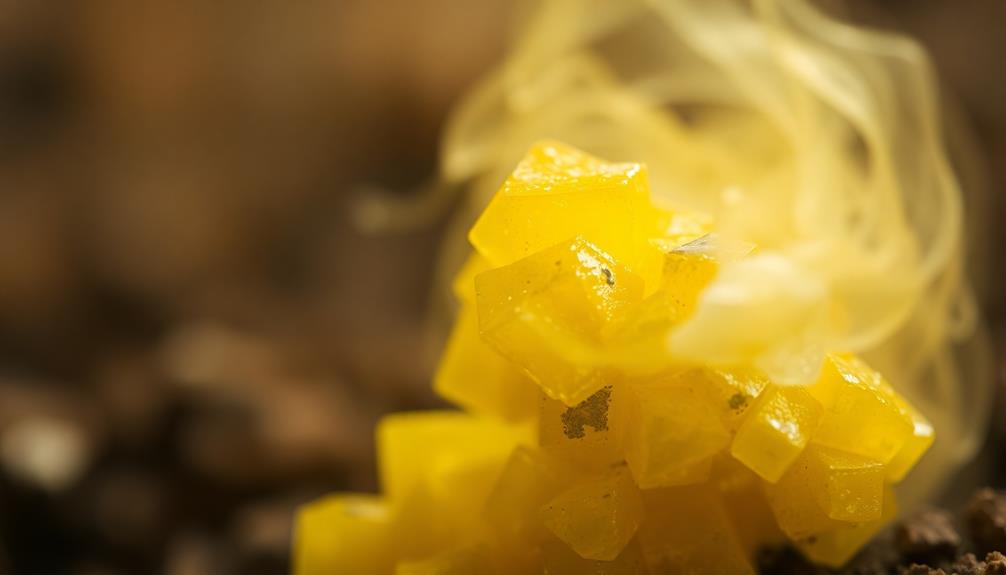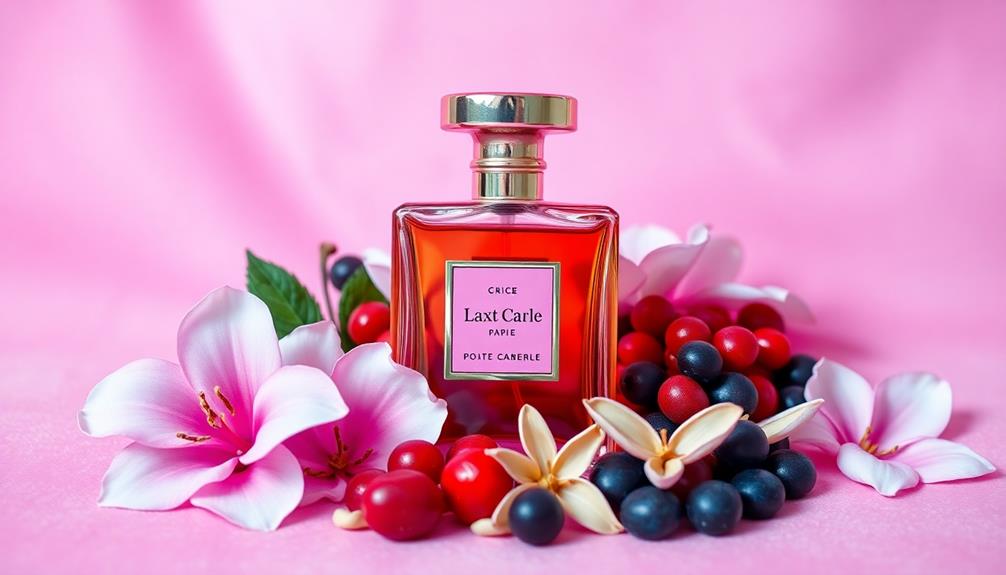Sulfur has a very sharp and pungent smell, often compared to rotten eggs. You might notice this scent in places like hot springs or near volcanoes. It's also found in some foods, like garlic and onions, where it adds to their flavor. When you breathe in sulfur, it can cause a stinging sensation in your nose, so be careful! This odor might not be pleasant, but it often signals that something important is happening in nature. Curious about where else you might encounter sulfur and what it means? There's more to discover!
Key Takeaways
- Sulfur has a sharp, pungent odor often likened to rotten eggs or burnt matches.
- The smell is associated with natural occurrences like volcanic eruptions and hot springs.
- Hydrogen sulfide, a compound of sulfur, is produced in low-oxygen environments and contributes to the odor.
- Sulfur odors can provoke discomfort and unease, often linked to decay and pollution.
- Safety precautions are crucial, as strong sulfur smells may indicate dangerous gas concentrations or spoilage.
Introduction
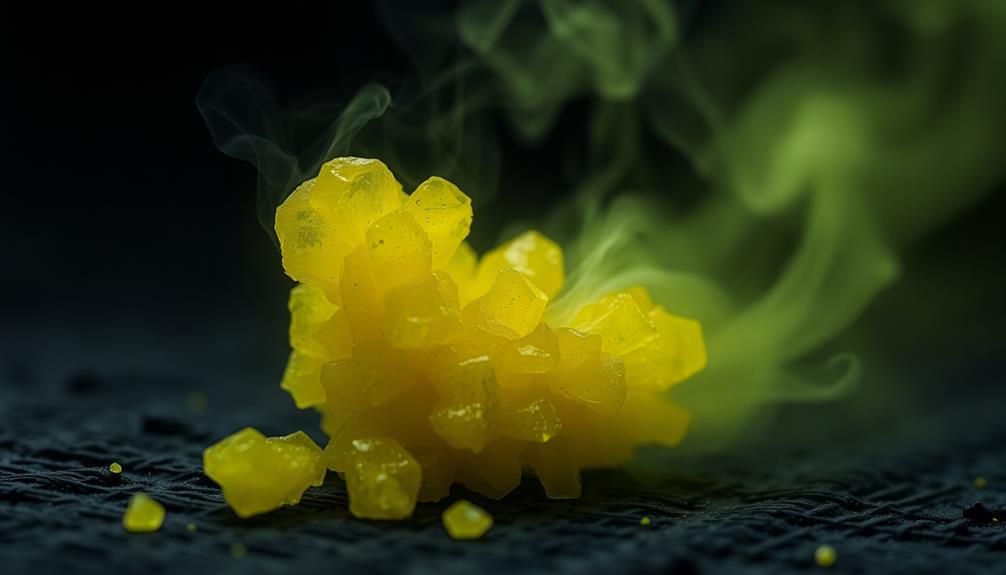
When you catch a whiff of sulfur, it's hard to mistake it for anything else. That distinctive smell often pops up in unexpected places, leaving you scrunching your nose and wondering what's going on.
Whether it's from rotten eggs, volcanic eruptions, or even some foods, sulfur's scent is pretty memorable. You mightn't know it, but this smell can help you identify certain things in your environment, and it's crucial in many scientific fields.
Understanding the sulfur smell is more than just a funny experience; it's a way to learn about nature and chemistry. For instance, did you know that sulfur compounds are often found in proteins? They play a big role in how food tastes, and that can be both good and bad!
While some people might find the smell off-putting, it's a vital part of many processes, from cooking to environmental science.
Next time you encounter that unmistakable odor, remember it's not just a nuisance; it's a signal and a clue to what might be happening around you.
Description of the Smell
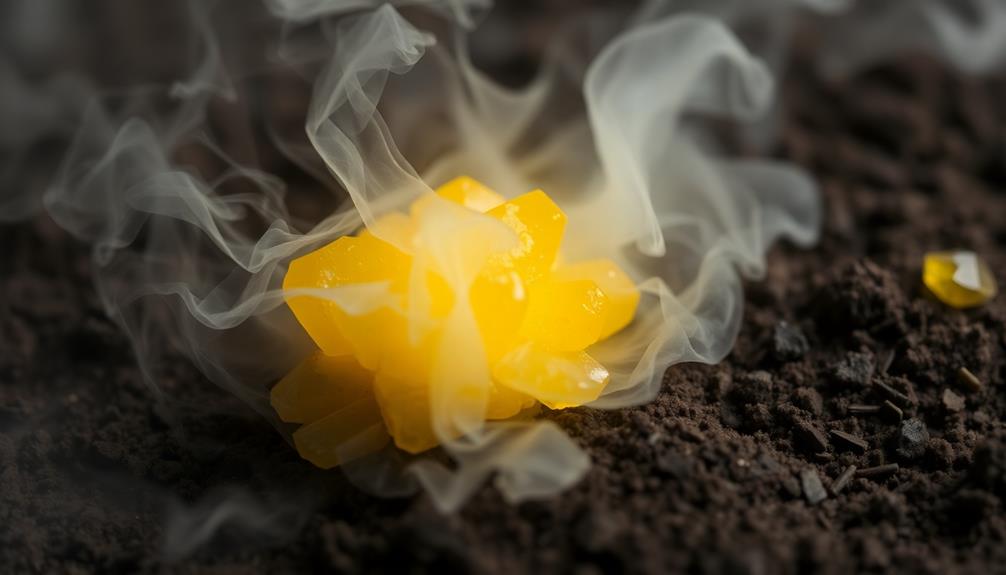
The moment you catch a scent of sulfur, it hits you like a punch in the nose—sharp, pungent, and unmistakable. You might even wrinkle your nose in reaction, as if you've just bitten into a sour candy. The smell has a distinctive quality, often described as rotten eggs or burnt matches. It's a strong odor that can linger in the air, making you aware of its presence even before you see the source.
When you breathe it in, you might feel a slight stinging sensation in your nostrils. This isn't just your imagination; sulfur compounds can create that tingling effect. It's not exactly a pleasant smell, but it's fascinating in its own right. You might find yourself wondering how something can smell so powerful and pervasive.
If you're in nature, the sulfur smell can sometimes remind you of hot springs or volcanic areas, where it's more common.
Source and Composition
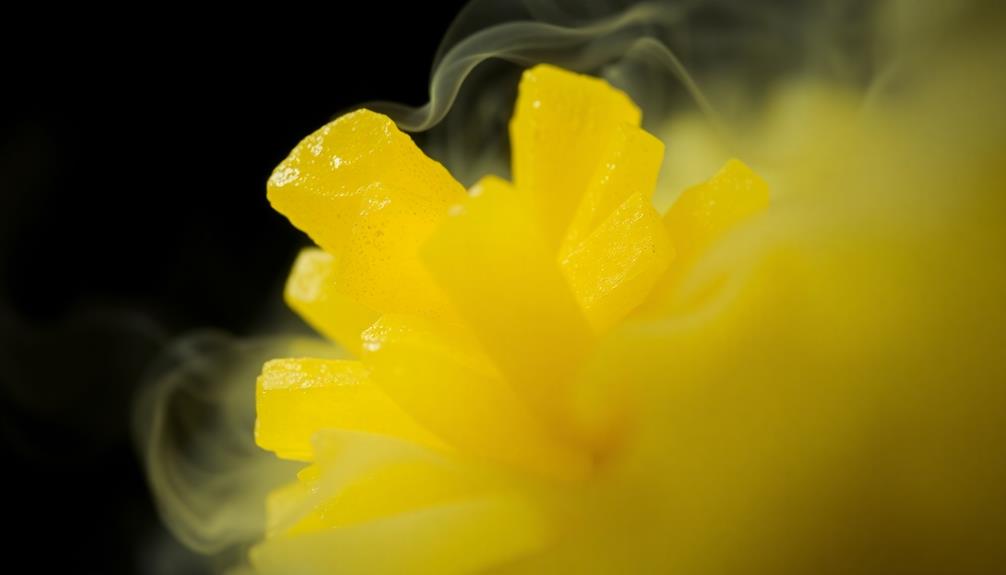
Sulfur's distinctive smell primarily comes from its natural occurrences and various chemical compounds. You might encounter sulfur in many places, from volcanic eruptions to hot springs. These natural sources release sulfur gases, which are often responsible for that infamous rotten egg smell.
But it's not just found in nature; sulfur compounds are also created during different processes, like burning fossil fuels or decomposing organic matter.
One common sulfur compound is hydrogen sulfide, which is produced when bacteria break down organic material in low-oxygen environments, such as swamps. When you think of sulfur, you might picture a bright yellow mineral, but it's the gases it forms that create that potent aroma.
Even in everyday life, sulfur compounds can pop up in foods like garlic and onions. They contribute to the flavor but also add to that unmistakable scent.
Typical Scenarios or Environments
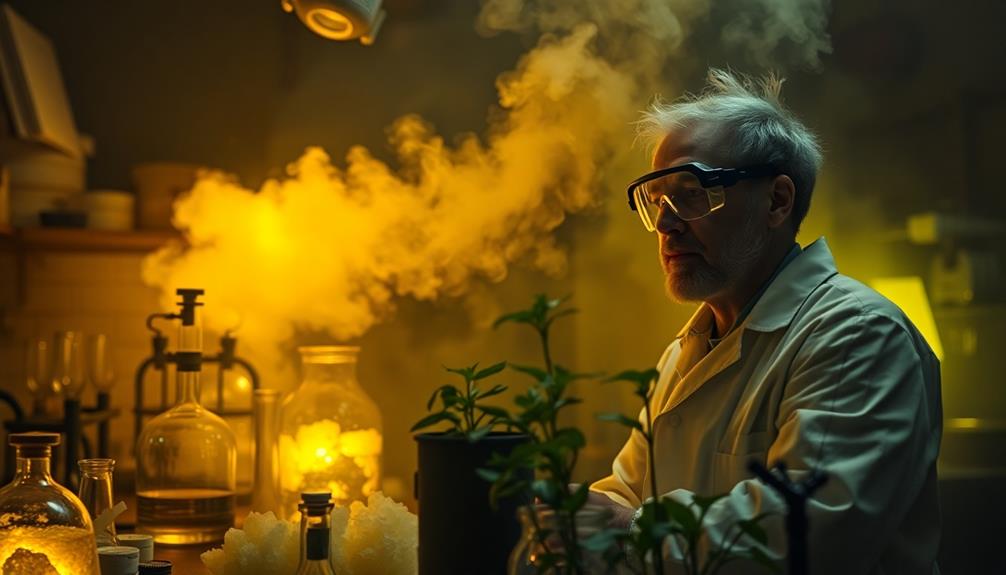
You might come across sulfur's signature smell in various everyday situations, especially in environments rich in organic decay or volcanic activity.
For example, if you stroll through a marshy area, you might notice a rotten egg scent wafting through the air. This smell often comes from sulfur compounds released during the decomposition of plant material.
Another typical scenario is when you visit a hot spring or geyser. These natural wonders often emit sulfurous vapors, reminding you of the Earth's incredible geological activity.
If you find yourself near a volcano, you might catch a whiff of that distinct smell as gases escape from the magma below.
Sometimes, you might even encounter sulfur in your own home, especially if you have a natural gas stove or a plumbing issue, as hydrogen sulfide can form in sewer systems.
While it's not the most pleasant scent, you can appreciate its role in nature and everyday life. Just remember, if the smell gets too strong, it's best to step back and investigate!
Who knew that something so stinky could be so fascinating?
Emotional or Cultural Associations

Many people associate the smell of sulfur with negative emotions, often linking it to decay, pollution, or unpleasant experiences. This connection can lead to feelings of unease or discomfort when you catch a whiff of it. Imagine walking near a landfill or a polluted river; the scent might instantly remind you of something rotten, making you wrinkle your nose and feel a bit queasy.
Culturally, sulfur has also been tied to superstitions and folklore. Some cultures view sulfur as a sign of bad luck or even evil spirits. You might recall stories where the smell of sulfur signals something sinister lurking nearby.
On the other hand, in some traditions, sulfur is seen as a purifying agent, helping to cleanse negative energy.
You might find that this mixed perception influences how you experience sulfur's scent. While you may not enjoy the odor, understanding its cultural significance can help you appreciate it a bit more.
Health or Safety Considerations
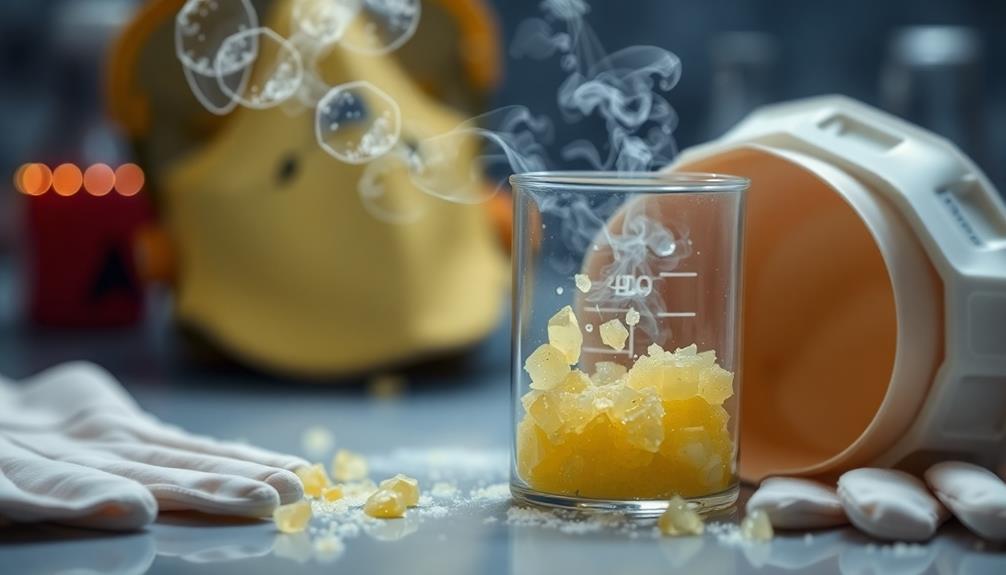
When exposed to sulfur compounds, it's essential to consider potential health risks. While sulfur itself isn't particularly harmful in small amounts, some sulfur compounds can be tricky. For instance, hydrogen sulfide, which smells like rotten eggs, can be dangerous in high concentrations. If you ever smell that odor, it's wise to get to fresh air quickly.
Even at lower levels, prolonged exposure to sulfur compounds might lead to irritation of your eyes, nose, or throat. You might experience headaches or dizziness, which is your body's way of saying, "Hey, something's off here!" If you're working in an area where sulfur is present, make sure you wear proper protective gear and follow safety guidelines.
In cooking, if you notice a sulfur smell, it might be time to check your ingredients. Spoiled food could emit these odors, and consuming it could lead to stomach issues. So, always trust your nose!
Keeping these health and safety considerations in mind will help you enjoy your culinary adventures while staying safe. Remember, a little precaution goes a long way in keeping your kitchen fun and healthy!
Final Thoughts
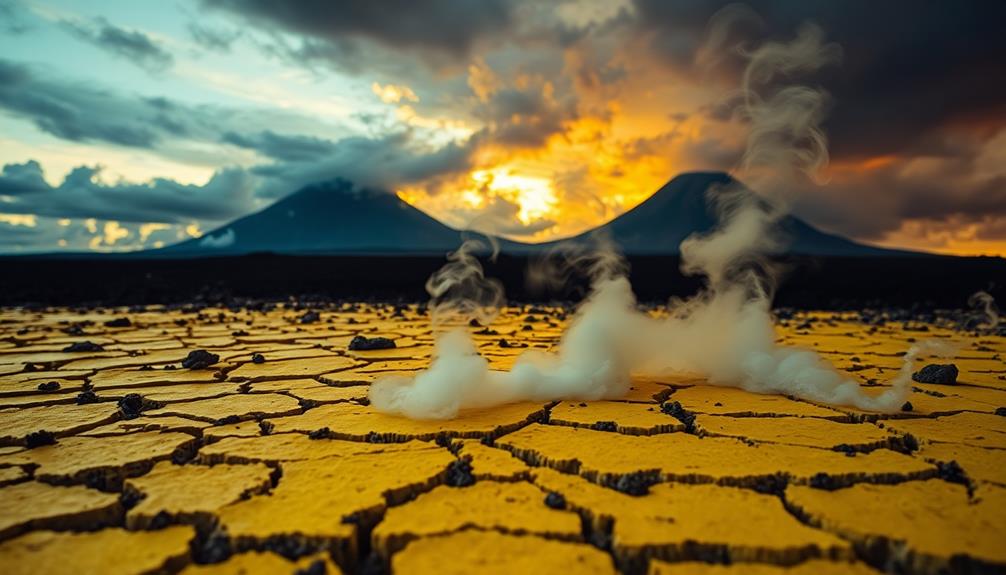
Understanding the implications of sulfur odors can enhance both safety and enjoyment in various environments. When you encounter that distinctive smell, often described as rotten eggs, it's essential to pay attention. This scent usually indicates the presence of sulfur compounds, which can be harmless in small amounts but might signal a problem in higher concentrations.
In homes, a sudden sulfur smell could mean a gas leak, and that's no joke! If you smell it, evacuate immediately and contact professionals.
At the same time, if you're exploring natural hot springs or certain foods, that sulfur aroma might just add to the experience. Remember, in moderation, even the most pungent smells can lead to delightful culinary adventures.
Frequently Asked Questions
Can Sulfur Smell Differ Between Natural and Industrial Sources?
Yes, sulfur's smell can differ between natural and industrial sources. You might notice that natural sulfur often has a milder, earthy scent, while industrial sources can emit a sharper, more pungent odor due to chemical processes.
What Are Some Common Misconceptions About the Smell of Sulfur?
Many people think sulfur only smells like rotten eggs, but it can vary based on its source. You might also confuse it with other odors, like burnt rubber or onions, leading to misconceptions.
How Does Temperature Affect the Perception of Sulfur's Smell?
Temperature influences how you perceive sulfur's smell; warmer conditions often intensify odors, making them more pungent. Conversely, cooler temperatures can dull your sense of smell, causing sulfur to seem less potent than it really is.
Are There Specific Animals That Can Detect Sulfur Better Than Humans?
Yes, certain animals, like dogs and rats, can detect sulfur better than you. Their olfactory systems are more sensitive, allowing them to pick up on subtle scents that you might not even notice.
What Are Some Historical Uses of Sulfur Based on Its Smell?
Throughout history, you'd find sulfur used in medicine, agriculture, and industry due to its distinct smell. Ancient cultures utilized it for purification, while alchemists sought its properties, believing it held transformative powers in their experiments.

